July 18-20, 2014
Glasgow, Scotland
My one regret the enitre weekend was not getting a picture with Dr. Meehan. I realized this regret the moment I began waving goodbye from the top deck of the open-roofed tour bus carting me away from the Riverside Museum toward the central train station early Sunday afternoon. Since Friday, she had been more than a kind hostess, she had taken me in as if I was her own daughter; this sentiment shown through in small, thoughtful actions – she had met me at the train station, bought me one of those tourist bus passes, gave up her bed while she slept on the couch, took me out to dinner, ensured a constant flow of biscuits and fresh fruit and wine, and put up with my rambling topics of discussion.
I first met Dr. Meehan back at Virginia Tech. I can’t trace when we first met. She taught Electronics I, but I had taken it with a different professor – was it when she substitute taught our class for a week? She was also a co-professor for the Future Energy Electronics Center, the lab I work in, but her main office/lab was in a different building – was it when she stopped by one time? At an office holiday party? Her daughter was also my office mate for a few months and we got along amazingly – both of us fans of Harry Potter and Converse shoes, both of us brilliant but feeling lost without a purpose as we changed from major to major, both of us awkward daughters of brilliant University Professors – was I helping Shannon help her mom carry boxes to their house? I don’t remember. A year ago on a whim she had applied to be a professor at the University of Glasgow; now she was here continuing her research and flying to China once a month to teach a class at the University’s satellite campus.
Glasgow is no Edinburgh (the other large iconic city of Scotland): it was working class, industrial, gritty. It rained – horribly, awfully, torrentially – the entire weekend. Through the rain, everything was foggy and grey. But inside – every museum, coffee shop, cathedral, restaurant, or apartment – was warm and intimate, like curling up by a fire in a cabin on a cold winter’s day with your favorite book and a cat. If Edinburgh is ostentatious and frenzied, Glasgow is relatable.
On Saturday, Dr. Meehan went into the University while I adventured on the tourist bus. It was one of those hop-on/hop-off things that allowed you to see the best sites without having to become a working-expert of the city’s transportation system. The woman giving the live tour on my first bus that morning looked and sounded like Merida.
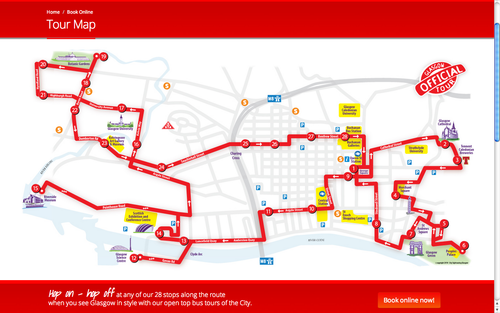
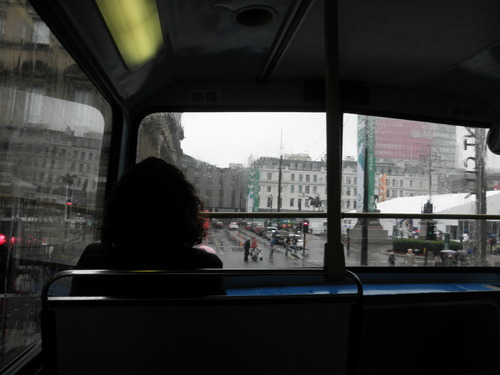
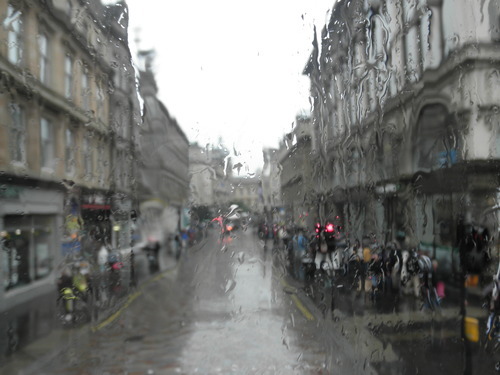
I rode from the furthest west to almost the furthest east non-stop. I first hopped off at the Glasgow Cathedral. A statue of David Livingstone (of the “Dr. Livingstone, I presume” African explorer fame) stood triumphantly at the head of a long, drenched walkway lined by flags toward the cathedral.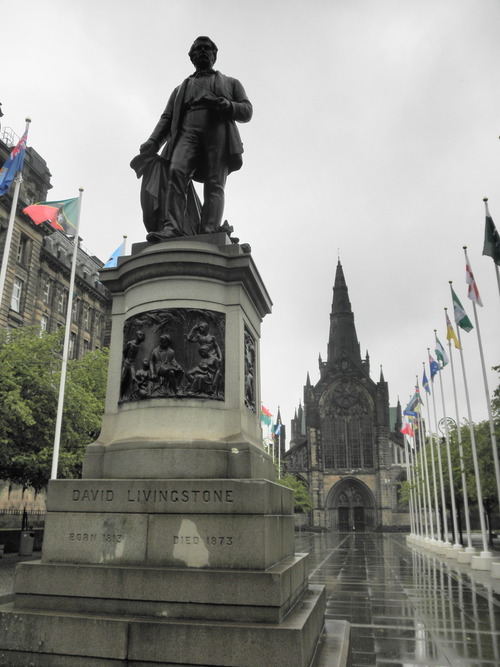
Inside, light barely eeked into the room, casting shadows highlighting the brooding nature of the gothic architecture. At the head of the church to the right stood an eagle podium with head stretched forward and wings spread; to the left an elevated lectern was inscribed with the latin phrase “per ardua ad astra” roughly translated as “through adversity to the stars.” Poofy helmets, unicorns, swords, and bearded and kilted statues memorialized the deceased rich and famous along every eye-level flat surface.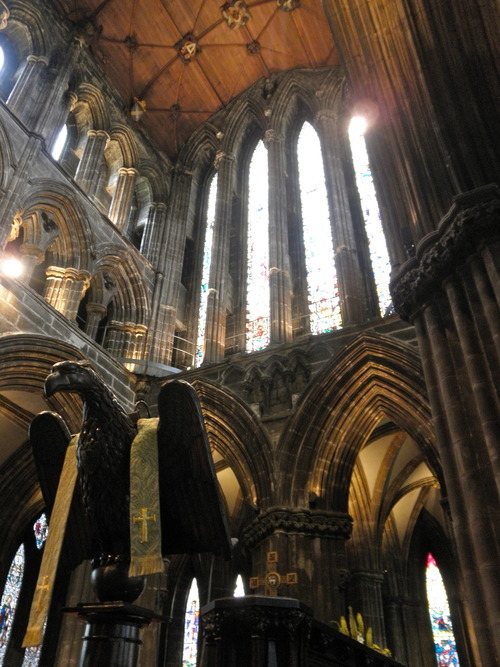

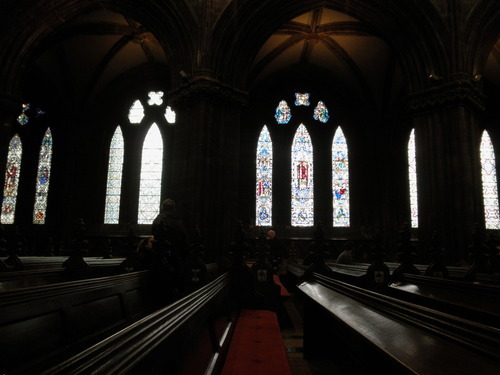
Winding along the side of a hill behind the cathedral sat the city of the dead, the Glasgow Necropolis. I got midway up the hill, yearning to read the inscriptions of the crumbling tombs and admire their view of the city, but the rain and cold picked up again and I ran shivering back to the bus stop.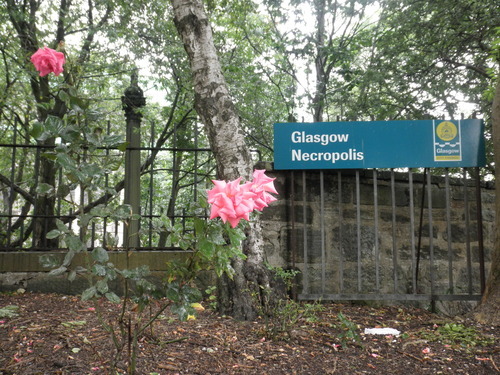
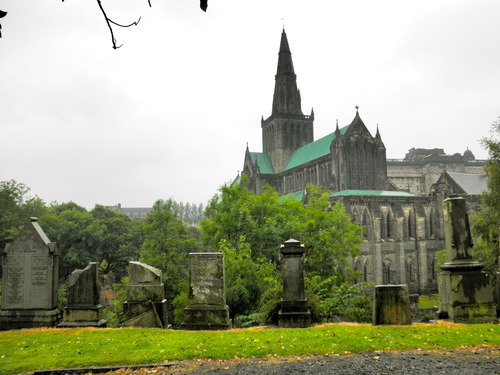
On the bus, I continued to learn snippets of the city’s history. Glasgow had been this preeminent industrial city. It was one of the first cities in the world to have an underground metro. It had blocks of stylish tenement housing that seemed to rival that of Paris. Along the banks of the Clyde, thousands of ships were built until a century later the industry disappeared and/or cheaper labor was found. Actually – the tour guide pauses for dramatic emphasis – there is a rumor that all of the ships produced by the John Brown Claybank company had to have a name ending in “ia.” The streak was broken when the ship builder bragged to the King that they would name their next ship after the ‘Greatest Queen of England’ – the King quickly responded, oh, my wife! And thus the ship could no longer be named Queen VictorIA. This story, while cute, makes little sense when I tried to research it – the company only has three ships named after Queens: Mary, Elizabeth, and Elizabeth II – only Elizabeth II makes contemporary sense and her husband would never be referred to as ‘King’. One of the more famous ships to emerge from Clydeside was the Lusitania (see? Another “ia” ship!). The infamous sinking of the Lusitania by German a U-boat spurred U.S. entry into World War I.
As the tour bus turned to cross the modern suspension bridge arching over the Clyde, protests of a modern war met us on the street. In the midst of the latest week-long bombing of the Gaza strip, Glasgow supporters of Palestine marched as a sea of green chanting and waving banners and flags. A mural celebrating the coming Commonwealth Games, a sort of Olympics amongst the former colonies of the British Empire, became their temporary backdrop. Which somehow felt symbolic. That all the things a multi-national sporting event encompasses – e.g. nationalistic pride from the non-violent triumph of a person from your country doing a lap in a pool slightly faster than someone else from another country – was silly idealism in the face the complex, seemingly un-solvable conflict that is Palestinian-Israeli relations. Those marching were passionate but peaceful, though it was unclear whether the outline of yellow policemen were there to halt their advance, protect them from opposition, or just monitor the situation. The live tour bus narrator waited several blocks in silence before returning to the scripted tour.
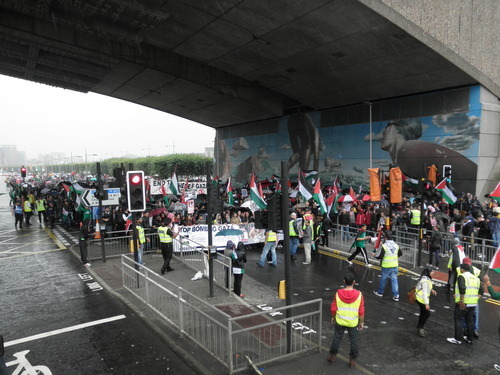
At the Kelvingrove art museum, I finally emerged from the bus with my feet rested, my curiosity peaked, and my limbs mostly dry once again. I gravitated toward the bright flowers in front of the building, hoping it would give the place a more cheery look amongst the gray; alas, somehow it just looks more menacing.
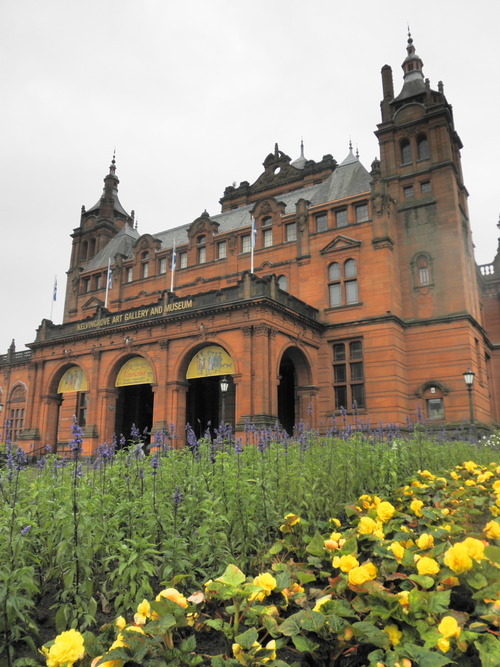
Inside, I set to work exploring. First, I traversed a narrow staircase to search for creatures of the past in the female toilets.
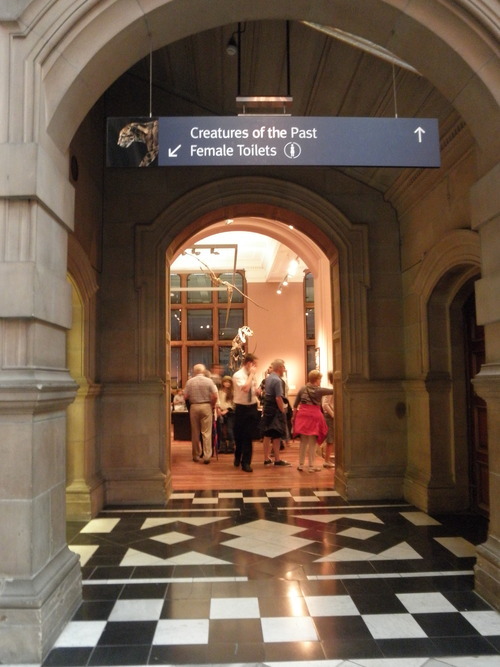
The theater of absurd continued with floating heads…
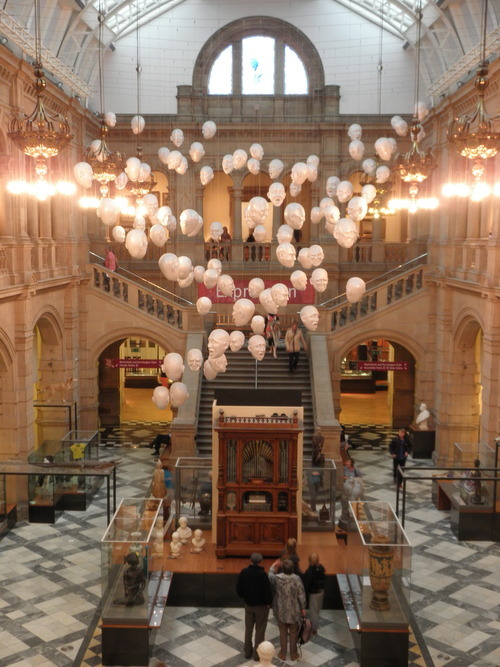
…and talking paintings
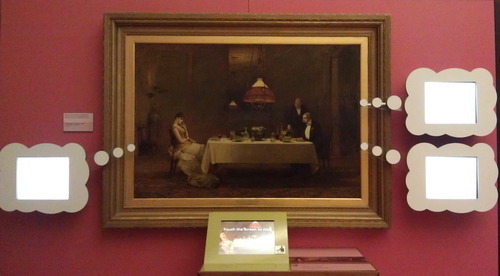
Actually, I quite enjoyed the painting above. Instead of nonchalantly looking and moving on, the visitor was invited to submit text they thought should belong in the thought bubble for the wife, husband, and butler. They were so amusing, I wrote some down:
“Oh dear, another night of silence”
“He brought the wrong wine again – life is so dull”
“Perhaps I shall get a poodle”
“If he gets that droopy mustache in the soup one more time…I’m outta here”
“Let’s serve pudding!”
The Kelvingrove was beautiful to wander around in. One moment you were admiring the peacocking of medieval armor…

…the next, you were dumbstruck with sadness. This sculpture below was simply titled “Motherless”.
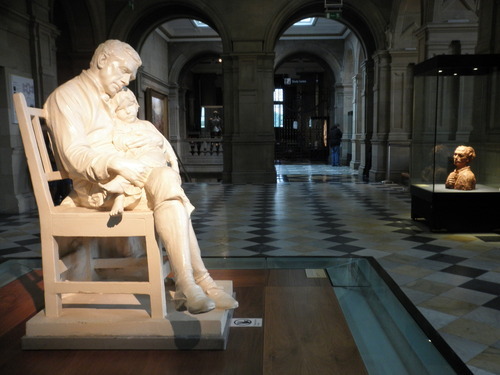
…At one point, I rounded a corner and strained my eyes to peer into the darkness past a crowd of people, only to find Dali’s Christ of St. John of the Cross:
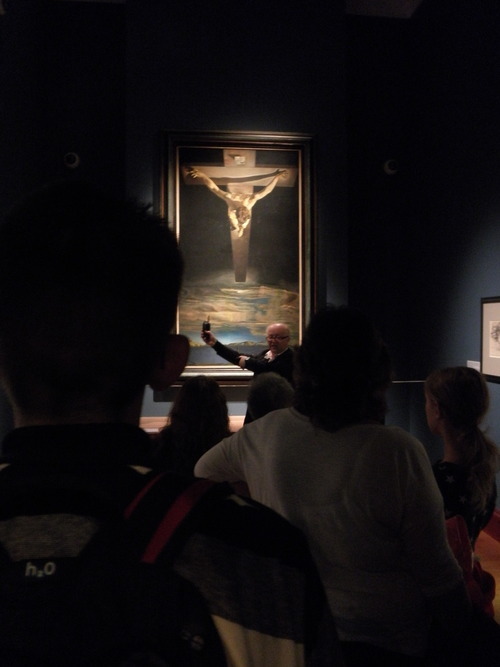
The impressionists captivated me until it was time to go (though every single quote on the wall was more the Impressionists defending their style than anything actually inspiring)
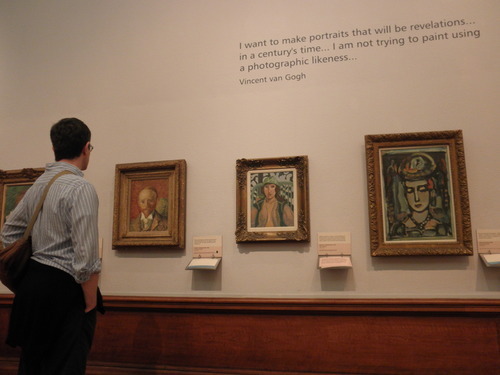
At dusk, I met back up with Dr. Meehan and toured the deserted campus where she pointed out all the pretty buildings and her own sort of ugly building (I feel like this always happens to engineers lol). She proudly showed off a few of the sites used in the filming of Harry Potter.
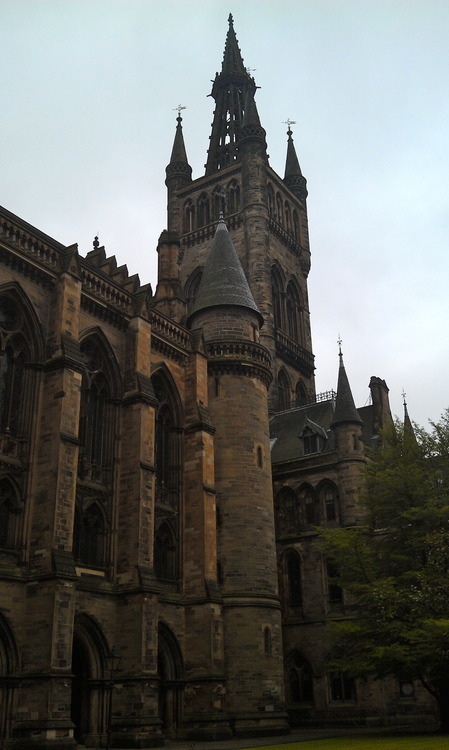
Over several glasses of beer and wine and dinner – at both a pub and restaurant near the university – we talked. About lab politics. About topics for my Master’s thesis. About vegetarianism. About how the number of women in Electrical Engineering hasn’t changed since she was in school. About how she thought Europe was supposed to be more progressive – yet when she arrived everyone made a point of asking if she was Ms. or Mrs. I was appalled by this – they didn’t refer to her immediately as Dr.? You hired her as a professor isn’t that obvious? We discussed how you should never change your last name because your publications get all screwed up. We discussed how the 10 pound Scottish note is both different and not accepted in England, though the 10 pound English note is accepted in both countries. We discussed how more Americans should come to University here because the Masters program is only 1 year long and a PhD is only 3-4 years (a full 1-3 years shorter than in the U.S!)
On Sunday, we set out from Dr. Meehan’s apartment in the far northwest corner of Glasgow. From the map it looked like we could take a long but leisurely stroll along the Kelvin river to the museum of transportation. [One of my favorite things about Glasgow was how thoroughly the city seemed to celebrate its scientific heritage. I mean, an ENTIRE RIVER was named after Lord Kelvin (as in degrees Kelvin). Downtown, there was a statue for JAMES WATT (steam engine dude) who also attended the University. I was geeking out all over the place.]

Remnants of a mill long ago abandoned lay still along our path.

Finally, we made it to where the Kelvin meets the Clyde. The Museum of Transportation had bicycles, tricycles, quadcycles, motor cycles, airplanes, double-decker buses, metro cars, three-wheeled cars, super old cars, hippie buses, train cars, fisherman boats, and many many more things – it was small child heaven, to the least. But outside was my favorite. An old tall ship let you climb aboard and explore life on deck. The nautical map room even had a map of the Chesapeake Bay by Commodore Maury! (A little bit of Norfolk everywhere I go!)
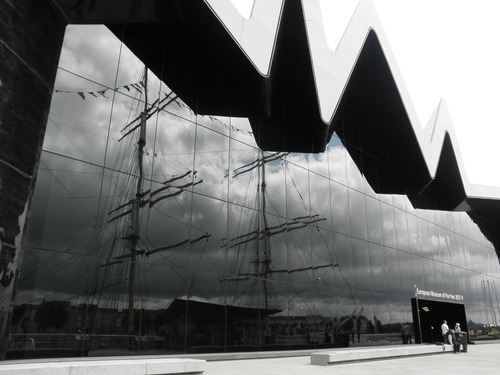
After the long (like super long) walk and touring the museum, I said goodbye to Dr. Meehan and boarded the tourist bus back downtown to catch my train. I ran to catch the last few sights I had missed in the rain, like this guy, whom either he or his horse must always be adorned with a traffic cone. (Apparently the police spend ridiculous amounts of money patrolling the statue and taking the cone down every day, yet a new one returns just as quickly – the modern art museum behind the statue, should really just adopt it – though then the cat and mouse game between police and the citizens of Glasgow would be over and that’s probably half the fun)
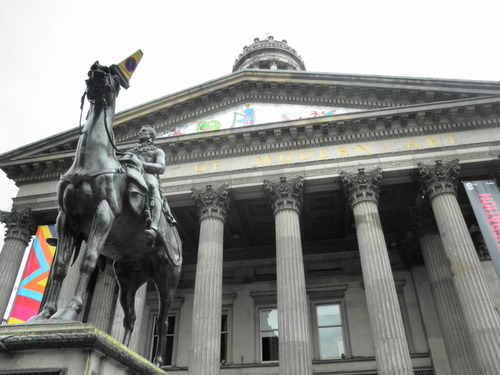
Though the Commonwealth games wouldn’t start for another week, Glasgow was in full swing for preparations.
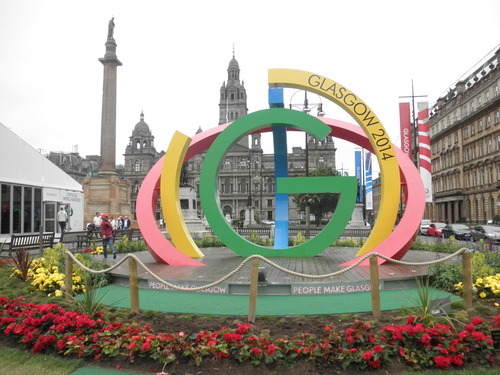
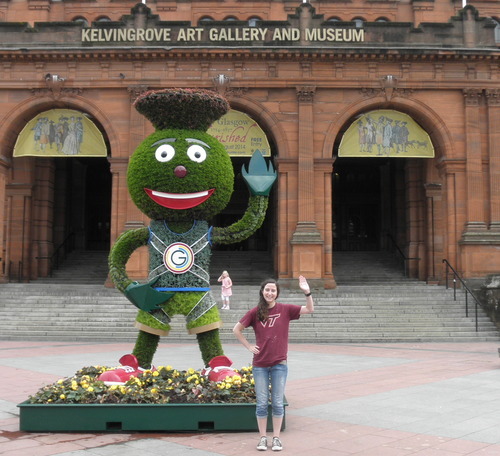
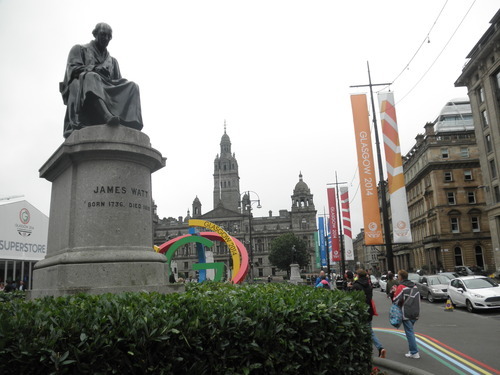
Until we meet again, Mr. Watt

